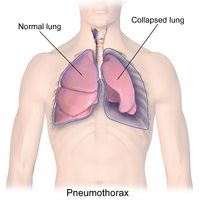
Photo from wikipedia
BACKGROUND Family presence during resuscitation is an emerging trend, yet it remains controversial, even in countries with relatively high acceptance of family presence during resuscitation among medical professionals. Family presence… Click to show full abstract
BACKGROUND Family presence during resuscitation is an emerging trend, yet it remains controversial, even in countries with relatively high acceptance of family presence during resuscitation among medical professionals. Family presence during resuscitation is not common in many countries, and medical professionals in these regions are unfamiliar with family presence during resuscitation. Therefore, this study predicted the medical professionals' intention to allow family presence during resuscitation by applying the theory of planned behaviour. DESIGN A cross-sectional survey. SETTINGS A single medical centre in southern Taiwan. PARTICIPANTS Medical staffs including physicians and nurses in a single medical centre (n=714). METHODS A questionnaire was constructed to measure the theory of planned behaviour constructs of attitudes, subjective norms, perceived behavioural control, and behavioural intentions as well as the awareness of family presence during resuscitation and demographics. In total, 950 questionnaires were distributed to doctors and nurses in a medical centre. RESULTS Among the 714 valid questionnaires, only 11 participants were aware of any association in Taiwan that promotes family presence during resuscitation; 94.7% replied that they were unsure (30.4%) or that their unit did not have a family presence during resuscitation policy (74.8%). Regression analysis was performed to predict medical professionals' intention to allow family presence during resuscitation. The results indicated that only positive attitudes and subjective norms regarding family presence during resuscitation and clinical tenure could predict the intention to allow family presence during resuscitation. CONCLUSIONS Because Family presence during resuscitation practice is not common in Taiwan and only 26.19% of the participants agreed to both items measuring the intention to allow family presence during resuscitation, we recommend the implementation of a family presence during resuscitation education program that will enhance the positive beliefs regarding family presence during resuscitation as they are a significant predictor of the intention to allow family presence during resuscitation. In addition, written policies and protocols for family presence during resuscitation are also needed to increase support from subjective norms regarding family presence during resuscitation practice.
Journal Title: International journal of nursing studies
Year Published: 2017
Link to full text (if available)
Share on Social Media: Sign Up to like & get
recommendations!